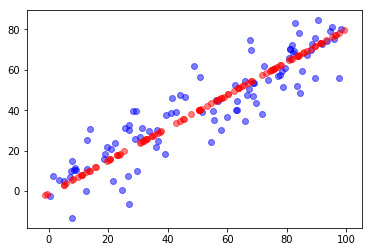自实现PCA
PCA模型封装
import numpy as npclass PCA: def __init__(self, n_components): """初始化PCA""" assert n_components >= 1, "n_components must be valid" self.n_components = n_components self.components_ = None def fit(self, X, eta=0.01, n_iters=1e4): """获得数据集X的前n个主成分""" assert self.n_components <= X.shape[1], \ "n_components must not be greater than the feature number of X" def demean(X): return X - np.mean(X, axis=0) def f(w, X): return np.sum((X.dot(w) ** 2)) / len(X) def df(w, X): return X.T.dot(X.dot(w)) * 2. / len(X) def direction(w): return w / np.linalg.norm(w) def first_component(X, initial_w, eta=0.01, n_iters=1e4, epsilon=1e-8): w = direction(initial_w) cur_iter = 0 while cur_iter < n_iters: gradient = df(w, X) last_w = w w = w + eta * gradient w = direction(w) if (abs(f(w, X) - f(last_w, X)) < epsilon): break cur_iter += 1 return w X_pca = demean(X) self.components_ = np.empty(shape=(self.n_components, X.shape[1])) for i in range(self.n_components): initial_w = np.random.random(X_pca.shape[1]) w = first_component(X_pca, initial_w, eta, n_iters) self.components_[i,:] = w X_pca = X_pca - X_pca.dot(w).reshape(-1, 1) * w return self def transform(self, X): """将给定的X,映射到各个主成分分量中""" assert X.shape[1] == self.components_.shape[1] return X.dot(self.components_.T) def inverse_transform(self, X): """将给定的X,反向映射回原来的特征空间""" assert X.shape[1] == self.components_.shape[0] return X.dot(self.components_) def __repr__(self): return "PCA(n_components=%d)" % self.n_components
使用
import numpy as npimport matplotlib.pyplot as plt# 准备数据X = np.empty((100, 2))X[:,0] = np.random.uniform(0., 100., size=100)X[:,1] = 0.75 * X[:,0] + 3. + np.random.normal(0, 10., size=100)# 求解2个主成分from playML.PCA import PCApca = PCA(n_components=2)pca.fit(X)pca.components_ # array([[ 0.76676948, 0.64192256], [-0.64191827, 0.76677307]])# 求解第一主成分pca = PCA(n_components=1)pca.fit(X)# 将数据降维(高维转为低维)X_reduction = pca.transform(X) # X_reduction.shape : (100, 1)# 将数据还原(低维转为高维)X_restore = pca.inverse_transform(X_reduction) # X_restore.shape : (100, 2)# 可视化# # 蓝色代表原数据,红色代表降维后在第一维的数据plt.scatter(X[:,0], X[:,1], color='b', alpha=0.5)plt.scatter(X_restore[:,0], X_restore[:,1], color='r', alpha=0.5)plt.show()

scikit-learn实现PCA
from sklearn.decomposition import PCA# 降维pca = PCA(n_components=1)pca.fit(X)# 求解第一主成分pca.components_ # array([[-0.77670058, -0.62987 ]])# 将数据降维(高维转为低维)X_reduction = pca.transform(X)# 将数据还原(低维转为高维)X_restore = pca.inverse_transform(X_reduction)# 可视化# # 蓝色代表原数据,红色代表降维后在第一维的数据plt.scatter(X[:,0], X[:,1], color='b', alpha=0.5)plt.scatter(X_restore[:,0], X_restore[:,1], color='r', alpha=0.5)plt.show()




